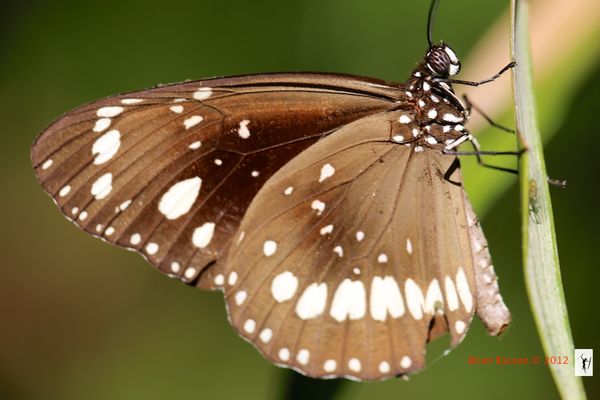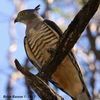Australian Crow Butterfly
Nov 26, 2012 19:25:31 #
Hi Nikonian, and all other macro photographers on UHH. I took this on Sunday, and was able to get really close with my Canon 100-mm macro lens, ISO 100, 1/250-sec at f/4.5. I believe that this is a true macro photo. Please critique and let me know what you think. Brian
Australian Crow Butterfly ♀

Nov 26, 2012 21:51:15 #
We cannot know if this is a macro or a close-up, without knowing size of butterfly. If it is about 1-inch (25-mm) from wingtip to feet, then this life-size, 1:1 magnification: a macro-photograph.
Nov 26, 2012 22:44:53 #
Nikonian72 wrote:
Hi Nikonian72, Thank you for responding so quickly and your input. I found the information below on the internet: We cannot know if this is a macro or a close-up, without knowing size of butterfly. If it is about 1-inch (25-mm) from wingtip to feet, then this life-size, 1:1 magnification: a macro-photograph.
Common Crow Euploea core
♂ 69 mm, ♀ 72 mm. Common dark brown butterfly with white spots and slow flight, usually fairly low. I think that these sizes are from wingtip to wingtip - Source: http://www.sunbittern.com/publications%20seq%20butterflies.pdf
In my opinion the butterfly that I photographed was within the size parameter that you provided. I hope that this helps? Brian
Nov 27, 2012 00:01:45 #
Shaka wrote:
Female = 72-mm wingtip-to-wingtip is difficult to translate to a folded-wing profile image, as you captured. Best method to capture macro is to have lens pre-set to manual MFD, then physically moving camera/lens set-up, in-&-out until focus is achieved. That point of focus is 1:1 magnification.In my opinion the butterfly that I photographed was within the size parameter that you provided. I hope that this helps? Brian
Nov 27, 2012 01:35:13 #
Nikonian72 wrote:
Hi Nikonian, I agree, it is probably impossible to translate wingtip-to-wingtip measurement to a folded wing profile. In any event, when I took this photo I started off by using manual; I think that I had the lens preset 1:1 and then moved my lens in and out, but after many shots I believe that I was manual focusing rather than moving in and out! What a disaster for me! Is my face red, or what! :oops: I'll try to remember keep to the rules next time. Many thanks, Nikonian, for your critique! Sincerely appreciated! :oops:Female = 72-mm wingtip-to-wingtip is difficult to translate to a folded-wing profile image, as you captured. Best method to capture macro is to have lens pre-set to manual MFD, then physically moving camera/lens set-up, in-&-out until focus is achieved. That point of focus is 1:1 magnification.
Nov 27, 2012 02:39:19 #
Most butterflies are too large to completely capture in a single macro-photographs, so overall photos, like yours, are needed, and are usually labeled 1:2 or 1/2 life-size, etc. Life-size images of most butterflies are just the head & body sections.
Nov 27, 2012 04:00:23 #
Nikonian72 wrote:
Thank you Nikonian72, appreciated.Most butterflies are too large to completely capture in a single macro-photographs, so overall photos, like yours, are needed, and are usually labeled 1:2 or 1/2 life-size, etc. Life-size images of most butterflies are just the head & body sections.
Nov 27, 2012 09:39:36 #
Nov 27, 2012 10:29:10 #
Nov 27, 2012 12:43:57 #
With my 60D plus 100mm L macro lens, to get a true macro shot I use a tripod, Live view so I can use the critical focusing magnification button, set the lens 1:1 set the focusing to manual and move in or out to get the focusing just right. The closest you can get is around 1 foot or(30cm) if I remember correctly. In my experience so far I have not been able to get so close or have the time to get a macro butterfly shot. Many people regard a cropped shot inlarged to lifesize makes a macro shot. I cant accept this as a macro even though it would be life size or bigger. This lens is very sharp and I have taken shots from 3 feet or more which when enlarged look to some like macro..regards :-)
Nov 27, 2012 13:21:28 #
Robbie7 wrote:
A 100-mm macro lens on a Canon camera with an APS-C sensor will capture "true macro" at 160-mm = 6.3-inches Working Distance (lens front element to subject). Anything farther away is a close-up capture.With my 60D plus 100mm L macro lens, to get a true... (show quote)
For printing or posting, it makes little difference if your crop in the camera (captured macro) or crop in post processing (captured close-up) to macro proportions.
Working Distance is a personal preference. For normal insect & arachnid photography, I prefer the greater DoF possible with close-up in the 1:2 to near 1:1 range, then cropped for composition, etc., in PP. For extremely small insects, MFD is my preference, and added cropping PP, to larger than life-size.
Nov 27, 2012 13:53:41 #
Hi Nikonian :-) Thanks for pointing out the crop factor, I knew when I was writing my comment that I had been able to get closer than 30cm but was too lazy to go into it in my head. I agree with point 2 i.e. printing and posting and also point no3 is why I dont shoot much macro either.The part I cant accept is when people refer to an enlarged close up as a macro. Thanks for responding :-)
Nov 27, 2012 15:16:22 #
rayford2
Loc: New Bethlehem, PA
Robbie7 wrote:
Can you tell if an image is an enlarged close-up or a true macro without any camera data?Hi Nikonian :-) Thanks for pointing out the crop factor, I knew when I was writing my comment that I had been able to get closer than 30cm but was too lazy to go into it in my head. I agree with point 2 i.e. printing and posting and also point no3 is why I dont shoot much macro either.The part I cant accept is when people refer to an enlarged close up as a macro. Thanks for responding :-)
Nov 27, 2012 18:30:34 #
Robbie7 wrote:
Enlarging & cropping a 1:2 (1/2 life-size) close-up to macro isn't too bad, but trying to crop a 1:3 or 1:4, or wider close-up, starts to fall apart when cropped to 1:1 mag (life-size). Original image resolution is the limiting factor when trying to crop a close-up to macro proportions. Same problem when trying to enlarge an image to print.Hi Nikonian :-) Thanks for pointing out the crop factor, I knew when I was writing my comment that I had been able to get closer than 30cm but was too lazy to go into it in my head. I agree with point 2 i.e. printing and posting and also point no3 is why I dont shoot much macro either.The part I cant accept is when people refer to an enlarged close up as a macro. Thanks for responding :-)
Nov 27, 2012 18:44:20 #
Hello Rayford :D I am going to stick my neck out here :( The quality of a macro shot depends on various factors e.g. Camera, lens, lighting, attachments used etc etc.
I can only speak as a Canon user but I know that the photos I take from several feet away i.e. non macro, when blown up to lifesize or more would be as sharp if not sharper and finer detailed than a photo taken with a less quality lens on macro setting. When I take a macro with my 100mm L lens the difference between it and a non macro from my lens is very noticeable. Why bother having a macro setting if it wasn't :-). So to answer your question without having the exif data it would be difficult, but generally in my opinion you can suspect, through experience when a blow up is just that. My pictures in the gallery of the Damselle fly taken on a fuji bridge camera were taken on the close up setting which has a macro symbol on it. The images though reasonable do not have the fine detail that my Canon would have , even in non macro mode. Maybe Nikonian72 knows some technical formula that I dont, so put the same qestion to him. I do know this I have never yet got so close to a jumping or fidgety insect to take its photo in true Macro (1:1). Obviously if you have the money for specialist equipment you could capture a flea in flight but how many on this site at our level would possess such kit. At the end of the day there is macro and macro. I have seen some amazing shots taken in macro as I am sure you have., but never one thats called macro, but been shot in non macro setting and blown up. Conclusion: Without exif data,I could not put hand on heart and swear I would definately know, but I bet I wouldn't be far out with my assumption .. :thumbup:
I can only speak as a Canon user but I know that the photos I take from several feet away i.e. non macro, when blown up to lifesize or more would be as sharp if not sharper and finer detailed than a photo taken with a less quality lens on macro setting. When I take a macro with my 100mm L lens the difference between it and a non macro from my lens is very noticeable. Why bother having a macro setting if it wasn't :-). So to answer your question without having the exif data it would be difficult, but generally in my opinion you can suspect, through experience when a blow up is just that. My pictures in the gallery of the Damselle fly taken on a fuji bridge camera were taken on the close up setting which has a macro symbol on it. The images though reasonable do not have the fine detail that my Canon would have , even in non macro mode. Maybe Nikonian72 knows some technical formula that I dont, so put the same qestion to him. I do know this I have never yet got so close to a jumping or fidgety insect to take its photo in true Macro (1:1). Obviously if you have the money for specialist equipment you could capture a flea in flight but how many on this site at our level would possess such kit. At the end of the day there is macro and macro. I have seen some amazing shots taken in macro as I am sure you have., but never one thats called macro, but been shot in non macro setting and blown up. Conclusion: Without exif data,I could not put hand on heart and swear I would definately know, but I bet I wouldn't be far out with my assumption .. :thumbup:
If you want to reply, then register here. Registration is free and your account is created instantly, so you can post right away.



